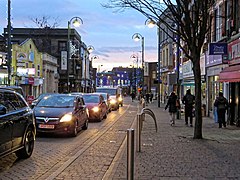
Back لیتنستون AZB Leytonstone Catalan Leytonstone Danish Leytonstone Spanish Leytonstone Basque لیتنستون Persian Leytonstone Finnish Leytonstone French Leytonstone Irish Leytonstone Italian
| Leytonstone | |
|---|---|
 Leytonstone High Road | |
Location within Greater London | |
| Population | 54,696 (wards, 2011)[1] |
| OS grid reference | TQ3987 |
| London borough | |
| Ceremonial county | Greater London |
| Region | |
| Country | England |
| Sovereign state | United Kingdom |
| Post town | LONDON |
| Postcode district | E11 |
| Dialling code | 020 |
| Police | Metropolitan |
| Fire | London |
| Ambulance | London |
| UK Parliament | |
| London Assembly | |
Leytonstone (/ˈleɪtənstoʊn/ LAY-tən-stohn) is an area in East London, England, within the London Borough of Waltham Forest. It adjoins Wanstead to the north-east, Forest Gate to the south-east, Stratford to the south-west, Leyton to the west, and Walthamstow to the north-west, and is 7 miles (11 km) north-east of Charing Cross.
Historically, it was part of the ancient parish of Leyton in the Becontree hundred of Essex. The first documented evidence of settlement is from the 14th century, describing a hamlet at 'Leyton-atte-stone'; a reference to the Roman milestone located within the area,[2] that formed a northern boundary of the parish.[3] It remained largely rural until the 19th century, becoming part of the London postal district in 1856, the same year its railway station was opened (now on the Central line). When Greater London was created in 1965, the Municipal Borough of Leyton merged with Chingford and Walthamstow to form the London Borough of Waltham Forest.
At the northern end of Leytonstone High Road is The Green Man; a public house and a nearby road junction under which the A12 runs.[4] Leytonstone is noted for being the birthplace of Alfred Hitchcock, with a number of references to the filmmaker around the area, including painted murals, mosaics, a pub and a hotel.[5][6]
- ^ "Waltham Forest Ward population 2011". Neighbourhood Statistics. Office for National Statistics. Retrieved 19 October 2016.
- ^ "London Borough of Waltham Forest: Archaeological Priority Areas Appraisal, October 2020" (PDF). Retrieved 2 August 2021.
- ^ "Leyton: Introduction | British History Online". www.british-history.ac.uk. Retrieved 12 September 2021.
- ^ "Leytonstone - Green Man Mural". 14 July 2021.
- ^ "Hitchcock Mosaics". 14 July 2021.
- ^ "The Birds, Leytonstone". 14 July 2021.
